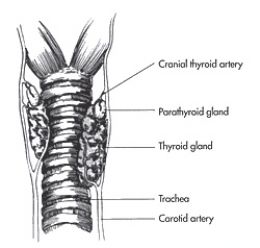Hyperthyroidism in Cats
by Dr. Arnold Plotnick
Section: Overview
Hyperthyroidism is a multisystemic metabolic disorder that occurs as a result of excessively high concentrations of thyroid hormones in the bloodstream. It is the most common glandular disorder in cats. Untreated hyperthyroidism results in increased cardiac output, and increased blood flow to the kidneys. Although the disease is treatable, in recent years it has become apparent that previously undetected kidney disease may suddenly be unmasked, and that known kidney disease may worsen in some cats after correction of their hyperthyroidism.
The disease is caused by excessive secretion of thyroid hormones by hyperplastic (overly large), usually benign thyroid glands. Although extensively studied, it is still not known why some cats develop hyperthyroidism while others do not.
There is no breed or sex predisposition for the disorder, but it occurs almost exclusively in older cats. Less than 6 percent of cases are younger than 10 years old. The average age of onset is 12 to 13 years.
The impact of the disease can be significant, as hyperthyroidism can affect many body systems, especially the heart.
What to Watch For
Weight loss
Ravenous appetite
Excessive drinking and urinating
Hyperactivity (restlessness, excessive vocalization)
Intermittent vomiting
Intermittent diarrhea
Panting
Diagnosis
Complete blood count
Chemistry panel
Urinalysis
Thyroid hormone level
Radiographs
Scintigraphy
Treatment
Antithyroid medication (tapazole)
Possible cardiac medication
Surgical removal of the thyroid glands (rarely done anymore)
Radioactive iodine therapy
Hill’s Prescription Diet Y/D
Consequences involving the kidneys can be minimized or prevented in hyperthyroid cats by assessing kidney function before undertaking therapy to treat the hyperthyroidism. Cats are then given oral medication to bring the thyroid hormone levels back into the normal range slowly, temporarily controlling the condition. Kidney function is then re-evaluated. If kidney function remains stable, a more permanent method of therapy (surgery, radioactive iodine) can be undertaken. If kidney function worsens, the veterinarian is faced with the dilemma of balancing the two disorders so that the most severe clinical signs of either disorder are kept to a minimum.
Home Care and Prevention
Consistently administer any prescribed anti-thyroid and/or cardiac medication if necessary. Treat for kidney failure (subcutaneous fluids, prescription diets, phosphate binders, gastric protectants, vitamin D supplements) if warranted and prescribed.
It is still not understood why some cats develop hyperthyroidism while others do not. Thus, there are no measures that can be taken to prevent the development of hyperthyroidism.





















